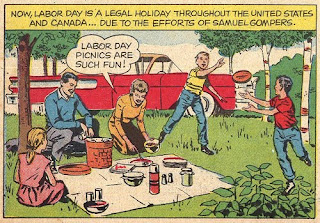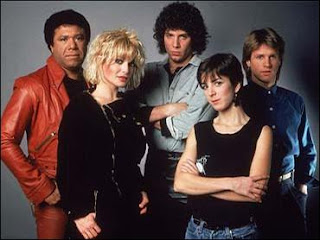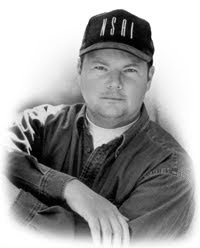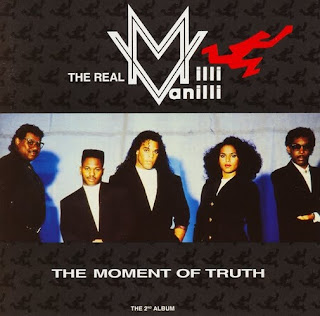In keeping with the whole Beatles buzz this week due to the release of their remastered CDs and video game, today’s video is from a group whose name was inspired by John Lennon’s Imagine. Imagination was a British trio from the early 80s that delivered some pretty cool R&B mostly while dressed in really retro gladiator style outfits. I’m not kidding.
Category: 80s music
Happy Retro Labour Day
When you think of labour day, you assume it was the brainchild of some tree huggin‘ Canadian or similar minded forward thinking country but in fact the Labour movement was born in the good ol‘ U.S.A. The idea of unions and worker’s rights was bred in the land known (and often hated by some ass backward countries) for it’s capitalists.
Samuel Gompers, an American, is the one to thank for the eight hour work days and worker’s compensation. He organized the American Federation of Labour and was their president for many years and helped make the American work force one of the highest paid in the world.
Ironically, another American named Sam, Sam Walton created an outlet for merchandise that is mainly made in non-unionized countries with low standards of living and deplorable work conditions with no benefits, which has led to some North American suppliers close their factories here and ship jobs off-shore. Go figure.
Something to think about as you chow down on chicken and tater salad at a Labour Day picnic. In honor of labour day, here’s a few videos with an obvious theme that relates to the nature of this much welcomed holiday.
Retro Video of the Day – Sweet Dreams / Pop Muzik
In keeping with the MTV theme from the posting the other day here’s two examples of videos that kind of show how quick some artists realized what a powerful media videos could be in giving their music a whole new dimension and got pretty serious about producing a quality video to go along with the song.
Eurythmics came on the scene with “Sweet Dreams” in the early 80s and as if Annie Lennox’s incredible voice wasn’t enough, you also got the cool visual imagery to accent the song and really solidify the mood and feeling it produced whenever you heard it afterwards. The images of the video made you think how it all connected to the song and it stayed with you. (Having said that – what’s with the cow in the video?)
By contrast, Pop Music by “M” (pronouned “Ehmm” – yeah, I’m kidding) was so hokey that it almost seems like a parody produced in someone’s basement. Everything from the cheap set to the seizure like dance routines make this video so bad it’s actually good. This song was a hit but I hope the dude didn’t spend all the money in one place – he sure as heck didn’t spend it on the video!
I Want My MTV – To Start Playing Music Videos Again
There was a time when having your song played on the radio in a regular rotation was the most critical aspect of music promotion. Getting on the air in major markets was paramount to success. It was all about the quality of the music and vocals, there was substance, there was talent, you didn’t have to be pretty or ruggedly handsome to have a hit record. Then it all went hell. Well, not at first.
In 1981, Music Television went on the air in the U.S. and single handedly changed the way music was marketed and promoted virtually overnight. MTV was the brainchild of Warner Communications and American Express, who funded Warners’ cable business but wanted a commercial outlet to reach the teen and young adult markets who traditionally have high disposable income.
When Warner and Amex gave the go ahead for the channel, the timing couldn’t have been worse. In the late 70s, record companies were hurting and looking to cut costs and one of the first things on the chopping block were music videos which were being produced for late night TV and specialty shows and were mainly filler on local channels.
At the time, videos were never really considered a necessity and some of the more avant garde artists like David Bowie and Talking Heads were using them as an artistic extension of their music but most bands were simply churning out performance videos either as concert footage or hokey and staged performances that they lip synched badly too. The consensus amongst the record companies was that videos had a negligible impact on sales. At the time they were probably right.
The race to get the channel on the air in 1981 was on before record execs completed their 1982 operating budgets. Before deciding on Music Television, MTV was almost dubbed TV-1 and TV-M for Television Music which really didn’t roll of the tongue to well so it was switched around and the young channel found it’s name. Now that they had a name, they went out and tried to get their hands on as many videos as they could. So how many videos did they have in their library on launch day? A whopping 250.
Original MTV VeeJays
Some record companies like MCA and Polygram flatly refused to be a part of the channel and didn’t provide any videos at all. The channel struggled to convince the companies that videos would help promote the artists and boost their record sales. Because of the fact that many record companies were slow to get on board, the video cupboard was kind of bare and heavily stacked towards certain artists. For example, thirty of the 250 videos on hand were Rod Stewart videos. Regardless, MTV figured once they showed some minor signs of success, the record companies would come around. So on August 1, 1981 MTV launched with its first video, the prophetic (yes, I’m talking about you Christopher Cross) “Video Killed The Radio Star” by the Buggles.
It didn’t really catch on with the cable companies at first. Their now infamous, “I want my MTV!” campaign changed all that and had thousands of people literally screaming the phrase to local video companies convincing them to add the new channel to their roster and it quickly swept across the U.S. and was making money by 1984. The influence it had on pop-culture was undeniable.
Christopher Cross- great face for radio
It was no longer good enough to have a good song as a musician, you had to have a look and a photogenic (videogenic? is that even a word?) face to make it. Network television took notice and tried to compete with shows like ABC Rocks and NBC’s Friday Night Videos but MTV was 24/7 music videos and nobody was doing that.
MTV had its share of controversy as well. For one thing, they refused to play ” Billie Jean” or anything else by Michael Jackson saying that “R & B” wasn’t what MTV was all about similar to why Country music wasn’t being played on MTV either. Ironically, Canada launched its music channel, Much Music, with “Billie Jean” as the first video they played. Upon closer inspection of the playing rotation for February 1983, MTV only had two videos being played that featured black artists: Tina Turner and the dude from The English Beat. MTV was given the ultimatum of either play “Billie Jean” or no more videos from CBS and their associated record labels. Obviously they caved and “Billie Jean” not only became iconic, but it changed the way most videos would be made going forward. It raised the bar to what a video can be – a visual representation of the song, not just a lip-synced, pseudo concert performance.
The second video aired on MTV
MTV did come around though. Four years later they launched “Yo! MTV Raps” and helped turn rap and hip-hop into the mainstream genre that it is today. Some of the other classic programming they provided over the years include their “Unplugged” acoustic series, Beavis and Butthead, Total Request Live (TRL), along with their various award shows. Along the way though they did lose sight of their roots and moved away from playing music videos to providing reality programming like Punk’d, The Real O.C., A Shot At Love, The Hills, The Ashley Simpson Show (Editor’s note: sweet baby Jesus, make it stop), The Surreal Life, The Osbournes, Pimp My Ride and a host of others that are numbing our children’s brains and providing zero cultural significance and making us all a wee bit shallower and dumb……….but I digress.
It’s interesting to wonder how many artists from the 80s and 90s would have even seen the light of day in North America if it wasn’t for the musical vehicle that was MTV.
Retro Video of the Day – I Just Can’t Get Enough
What better way to start a Friday than with a Retro classic from the early 80s from an influencial band that is still around today? Depeche Mode’s “I Just Can’t Get Enough” from their album Speak and Spell was the first single they released in the U.S. though they released two others songs before this in the U.K.
The song reached number 8 in the Uk Singles chart and number 26 on the U.S. Hot Dance Music / Club Play charts. This was the final song written by Vince Clark before he left to team up with Alison Moyet to form Yazoo (later changed to Yaz) and is the only Depeche Mode video to feature Vince Clark. It’s also the last video anywhere with Vince Clarke featuring a full head of hair with no shaved areas. I tend to nit pic with my trivia at times.
Retro Video of the Day – Baby Don’t Forget My Number
The buzz that surrounded the sudden emergence of German dance group Milli Vanilli back in the late 80s was huge. Fab Morvan and Rob Pilatus, the faces (notice I didn’t say lead singers) behind Milli Vanilli took the dance floors by storm when they dropped an album out of nowhere that spawned a number of hits, massive international sales, numerous American Music Awards and a Grammy for Best New Artist in 1990.

Then it all imploded when it was revealed that they didn’t actually have anything to do with the creation of the album nor did they sing a single note on any of the songs either in the studio or live. When producer Frank Farian put the project together, the original group lacked what he felt was a marketable image so he found Rob and Fab to front the group in videos not realizing the huge success that would come and the demand for live performances that followed.
During a “concert”, their equipment failed which revealed they had been lip synching the whole time and their critics pounced on the issue and escalated it to the point where their Grammys were revoked and their record label not only dumped them but deleted the album and the masters from their catalog forcing the album out of print.
They attempted a few comebacks with them actually singing but they never achieved the same success. On the eve of the release of their final attempt at a comeback album that used the original Milli Vanilli singers as backup, Rob Pilatus was found dead in a hotel room as a result of a drug overdose. A problem he picked up after the scandal broke. Fab went on to be a radio DJ and even released a solo album but never achieved the same level of success or fame.
The original unmarketable Milli Vanilli
Interesting note – Frank Farian, the producer that was responsible for the whole mess has over 800 gold records and is responsible for some very successful German dance acts like La Bouche and Le Click as well as No Mercy and produced a Meatloaf album. He was also the guy behind the success of Boney M in the 80s.
The video may not prove they couldn’t sing, but they sure couldn’t dance either!
Retro Classic Bonus!
Is it me or does it look like they’re lip synching? (Just sayin’…..)
Retro Video of the Day – Blind Vision
There are many bands that truly embody the 80s electro-synth sound and Blancmange would have to be high on that list. Riding the wave of the 80s electro revolution, Blancemange was growing in popularity alongside the likes of Depeche Mode, Ultravox, Soft Cell and other bands forging a new sound for the decade.
Although their first real major hit was “Living on the Ceiling”, they did have some other decent songs that charted fairly well. “Blind Vision” reached number 10 in the UK in 1983 thanks in part to this creepy video. The group recently reformed and are working on new material for a new album.
Scan for other cool blogs using Condron at www.condron.us






